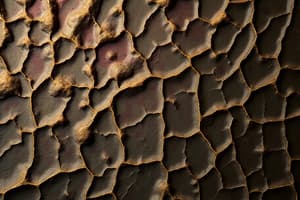Podcast
Questions and Answers
What type of tissue forms the inner lining of the mouth?
What type of tissue forms the inner lining of the mouth?
- Phloem
- Epithelial tissue (correct)
- Tendons
- Adipose tissue
Which tissue connects muscle to bone in humans?
Which tissue connects muscle to bone in humans?
- Protective tissue (cork)
- Phloem
- Tendons (correct)
- Epithelial tissue
What is the role of the epidermis in plants?
What is the role of the epidermis in plants?
- Transports food in plants
- Allows exchange of gases and transpiration through stomata (correct)
- Connects muscle to bone in plants
- Stores fat in plants
In which regions is parenchyma tissue present in plants?
In which regions is parenchyma tissue present in plants?
What type of tissue is present in the vascular bundle of plants?
What type of tissue is present in the vascular bundle of plants?
Which type of tissue is present in the lining of kidney tubules?
Which type of tissue is present in the lining of kidney tubules?
What is the function of the thick waxy coating of cutin in the epidermis of desert plants?
What is the function of the thick waxy coating of cutin in the epidermis of desert plants?
How does the cork act as a protective tissue in plants?
How does the cork act as a protective tissue in plants?
What is the main reason for cells of cork being dead and compactly arranged without intercellular spaces?
What is the main reason for cells of cork being dead and compactly arranged without intercellular spaces?
Why is the deposition of suberin on the walls of cork cells important?
Why is the deposition of suberin on the walls of cork cells important?
Flashcards are hidden until you start studying
Study Notes
Tissue Types in Humans and Plants
- The inner lining of the mouth is formed by stratified squamous epithelium, providing protection against abrasion and pathogens.
- Tendons are the connective tissues that link muscle to bone in humans, allowing for movement through muscle contraction.
Plant Epidermis and Its Functions
- The epidermis in plants serves as a protective outer layer, preventing water loss and shielding against environmental damage.
- In desert plants, the thick waxy coating of cutin on the epidermis minimizes water evaporation, adapting to arid conditions.
Parenchyma Tissue in Plants
- Parenchyma tissue is extensively found in various regions of plants, including the cortex, pith, and mesophyll of leaves, contributing to storage, photosynthesis, and healing.
Vascular Bundle and Tissue Composition
- The vascular bundles in plants consist of xylem and phloem tissues, essential for transporting water, nutrients, and food throughout the plant.
Renal Function and Tissue
- The lining of kidney tubules is comprised of cuboidal epithelium, important for absorption and secretion processes involved in urine formation.
Protective Functions of Cork
- Cork acts as a protective tissue in plants by forming a barrier against physical damage, pathogens, and water loss.
- Cork cells are dead and tightly packed, resulting in no intercellular spaces, providing structural integrity and resistance to external stressors.
Importance of Suberin in Cork Cells
- The deposition of suberin in cork cell walls is crucial for creating an impermeable layer that prevents water loss and protects against pathogens.
Studying That Suits You
Use AI to generate personalized quizzes and flashcards to suit your learning preferences.



